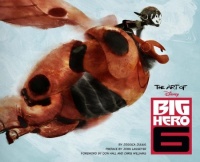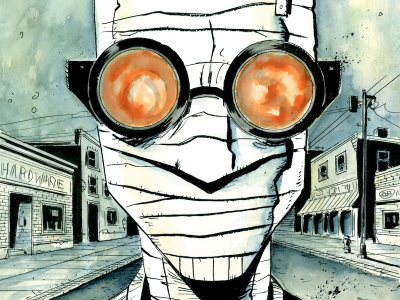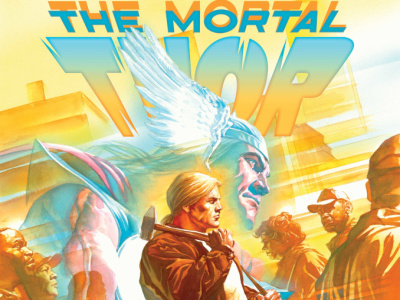 Confessions of a Comic Book Guy is a weekly column by Steve Bennett of Super-Fly Comics and Games in Yellow Springs, Ohio. This week, Bennett talks about what he would like to see more of in contemporary comics.
Confessions of a Comic Book Guy is a weekly column by Steve Bennett of Super-Fly Comics and Games in Yellow Springs, Ohio. This week, Bennett talks about what he would like to see more of in contemporary comics.I reviewed Jessica Julius' book The Art of Big Hero 6 for ICv2 (see "Review: 'The Art of Big Hero 6' HC") and don't plan to re-review it here. However there were a couple of details in it that are worth repeating. Like not only was Marvel's Joe Quesada totally onboard with the film diverging from the original comics, he was the one who proposed that the film's central premise be about a boy and his robot. And that comic book artists Geoff Darrow and John Romita, Jr. worked on the film. But there were a couple of items of interest in it that I didn't get to, and they appeared in the book's preface by Pixar/Walt Disney chief executive officer John Lasseter. Two things which he says are important aspects of all his movies. Which are also things I'd like to see more of in contemporary comics.
When seeing one of his movies he wants audiences to say, "Wow, I haven't seen this before." They could have gone the obvious route and given the movie an "anime" look but instead decided on creating an original setting, the polyglot locale of San Fransokyo. This is something that caused a certain amount of consternation among online pundits before the movie's release. This struck me as kind of odd, seeing as how cut and paste European settings are a stable of anime (particularly the films of Hayao Miyazaki, Kiki's Delivery Service, My Neighbor Totoro). But then genre fans really don't want to see something new; they want to see the same old thing, only this time somehow, some way "better." Which is I suppose why in Summer 2015 Marvel will be doing do-overs of Secret Wars, Civil War, Age of Ultron Vs. Marvel Zombies and Planet Hulk.
Lasseter also stresses the importance of doing research. It's nothing new. The Walt Disney Company has always known how important it is to ground a fantasy in reality and routinely sends their artists all over the world on research trips. And while Baymax may seem fanciful, he's the result of the producers trying to create a robot that's never been seen before, and a trip to the Carnegie Mellon soft robotics lab. Anyone doing ten minutes of online research would easily find that flexible robots that can safely interact with humans is cutting edge technology.* And yet in comics "metal monsters" (as Chris Atkeson, a professor in the university's Robotics Institute calls them) like The Avengers' Ultron are still the industry standard.
It's because, in my opinion, comic book iconography is still rooted deep in a 1930's derived sensibility where mad scientists (preferably in pharmacist jackets and steampunk goggles) single-handedly create rampaging robots. While other media try to avoid demonizing the mentally ill (or at least they've updated to a more contemporary trope; the suave sociopathic serial killer) in comic books escaped homicidal maniacs remain popular villains. As I have previously pointed out (see "Confessions of a Comic Book Guy--See The Wizard") Arkham Asylum still exists in the DC Universe. In spite of the fact there are effectively no longer any asylums; they were replaced by psychiatric hospitals decades ago.
The "New 52," when DC was busy updating and revamping their characters, was the perfect opportunity for the publisher to turn Arkham into a psychiatric hospital. But they didn't, I honestly don't know why, most likely because thanks to the video game Batman: Arkham Asylum is a recognizable, popular brand and nobody wants to mess with one of those. But also it was no doubt also because they liked the alliteration, as well as the pulpy "glamour" of a 19th Century mad house no matter how are archaic it is. You could argue that no one should expect "reality" from comics about a millionaire vigilante dressed up like a flying rodent, and you'd have a point. But to me it reminds me of the way Hank Ketchum had Dennis the Menace attending the same Cowboy Bob westerns he saw in the 50's well into the 1980's. Ketchum didn't want to send Dennis to space movies because he was comfortable with the ways things were, the way he had always done them. It's a minor thing, I agree, but it's also a discreet way of announcing that you're not interested in reflecting the real world. And once you've done that it's a short ride to irrelevance.
Oh, there was a third thing he said in the preface; the number one thing that Lasseter wants to know is "where will the heart come from?" But then, I sadly don't expect to see a whole lot of "heart" in American comics these days.
* For the record artist/writer Paul Pope created an inflatable robot named THB in the 1994 comic of the same name which predates its real world counterparts.
The opinions expressed in this column are solely those of the writer, and do not necessarily reflect the views of the editorial staff of ICv2.com.








